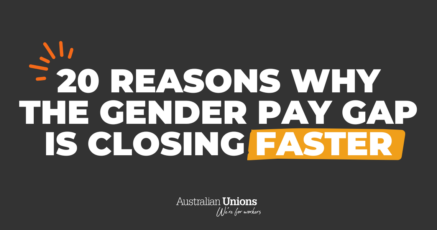If you’re a woman doing paid work in Australia, the gender pay gap you experience is bigger than women workers elsewhere in all corners of the globe. In total, there are 42 countries around the world that rank better than Australia in 2022. Forty-two. What does this say about our quality of working life here?
Today is Equal Pay Day which marks how many more days on average women must work to earn the same pay as men. For this year, that is 60 days starting from the end of financial year.
The 60 days reflects the current 14.1 percent gap in full time ordinary earnings between men and women, leaving working women $264.30 worse off per week than their male counterparts.
Although the gender pay gap has narrowed over time, progress is stalling and we are failing to keep up with the rest of the world.
The impact of unfair pay affects women for their entire lives, not just while they are working. Women, on average, retire with superannuation balances almost half that of men.
These gendered divisions are caused by structural sexism in Australia’s economy and workplaces. When we look past the 14.1 per cent figure, we see many ways in which working women from all sectors of the workforce suffer from the sexist gap.
Causes of gender pay gap make it near impossible to avoid
Even if you might make it as the one token woman on a company board, there is no guarantee of fair pay for the women workers at the company.
Despite all the talk of ‘smashing the glass ceiling’ when a company has a woman in a senior position, even senior executives still face a whopping gender pay gap of nearly $100,000.
We can also see how difficult it is for women to achieve higher levels of income in the first place. With women more likely to be working in undervalued work such as teaching, nursing and care, may are found in the lower pay brackets.
But only 20 per cent of the gender pay gap is explained by women working in lower-paying industries. The ACTU report also highlights how the gap reflects that many women leave work to give care and that gender discrimination continues to play the biggest role.
These additional factors mean fewer than half of women work full-time across all age groups.
This disparity is important to note because when we talk about the gender pay gap, we are referring to the difference between full-time earnings. But when we consider that so many women are in part-time or casual work, the pay gap figure is far higher than 14.1 per cent.
Women in unions on a more equal footing
The causes of the gender gap are complex and so solutions need to be broad to address this inequality found in workplaces across Australia.
But women shouldn’t have to wait while we work to reduce the 14.1 per cent gap. Union members are already making sure women are treated with respect at work and have made massive gains for gender equity.
Whether it’s removing sexist pay secrecy clauses or ensuring a better pay deal for women, workers in unions are creating fairer workplaces for all workers.
As union members, our actions are never for the advancement of the individual alone. That’s why we act to make changes that benefit everyone.







SHARE:
Women are working 60 days more to earn the same as men